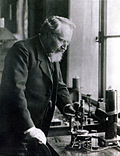Liquid crystal
Liquid Crystal
Liquid crystals are a state of matter that has properties between those of conventional liquids and those of solid crystals. For instance, a liquid crystal may flow like a liquid, but its molecules may be oriented in a crystal-like way. There are many different types of liquid crystal states, which can be distinguished by their different optical properties (such as birefringence).
History[edit]
The existence of the liquid crystal state was first recognized by the Austrian botanist Friedrich Reinitzer in 1888. He discovered that cholesteryl benzoate, a compound extracted from carrots, had two distinct melting points. At the first melting point, the compound became a cloudy liquid, and at the second melting point, it cleared up and became a transparent liquid.
Types of Liquid Crystals[edit]
There are three common types of liquid crystals: nematic, smectic, and cholesteric (or chiral nematic). Each type has a different arrangement of molecules and different optical properties.
Nematic Liquid Crystals[edit]
In the nematic phase, the molecules are aligned in parallel but are not arranged in well-defined planes. This is the simplest type of liquid crystal, and it is the type most commonly used in liquid crystal displays (LCDs).
Smectic Liquid Crystals[edit]
In the smectic phase, the molecules are aligned in parallel and are also arranged in well-defined planes. There are several different types of smectic phases, which are distinguished by the different arrangements of the planes.
Cholesteric Liquid Crystals[edit]
In the cholesteric phase, the molecules are aligned in parallel, but they are arranged in a helical structure. This type of liquid crystal is used in some types of liquid crystal thermometers.
Applications[edit]
Liquid crystals have many applications. They are used in liquid crystal displays, which are used in a wide variety of electronic devices such as televisions, computer monitors, and digital clocks. They are also used in liquid crystal thermometers, and in the field of liquid crystal on silicon (LCoS) technology.
Ad. Transform your life with W8MD's Budget GLP-1 injections from $75


W8MD offers a medical weight loss program to lose weight in Philadelphia. Our physician-supervised medical weight loss provides:
- Weight loss injections in NYC (generic and brand names):
- Zepbound / Mounjaro, Wegovy / Ozempic, Saxenda
- Most insurances accepted or discounted self-pay rates. We will obtain insurance prior authorizations if needed.
- Generic GLP1 weight loss injections from $75 for the starting dose.
- Also offer prescription weight loss medications including Phentermine, Qsymia, Diethylpropion, Contrave etc.
NYC weight loss doctor appointmentsNYC weight loss doctor appointments
Start your NYC weight loss journey today at our NYC medical weight loss and Philadelphia medical weight loss clinics.
- Call 718-946-5500 to lose weight in NYC or for medical weight loss in Philadelphia 215-676-2334.
- Tags:NYC medical weight loss, Philadelphia lose weight Zepbound NYC, Budget GLP1 weight loss injections, Wegovy Philadelphia, Wegovy NYC, Philadelphia medical weight loss, Brookly weight loss and Wegovy NYC
|
WikiMD's Wellness Encyclopedia |
| Let Food Be Thy Medicine Medicine Thy Food - Hippocrates |
Medical Disclaimer: WikiMD is not a substitute for professional medical advice. The information on WikiMD is provided as an information resource only, may be incorrect, outdated or misleading, and is not to be used or relied on for any diagnostic or treatment purposes. Please consult your health care provider before making any healthcare decisions or for guidance about a specific medical condition. WikiMD expressly disclaims responsibility, and shall have no liability, for any damages, loss, injury, or liability whatsoever suffered as a result of your reliance on the information contained in this site. By visiting this site you agree to the foregoing terms and conditions, which may from time to time be changed or supplemented by WikiMD. If you do not agree to the foregoing terms and conditions, you should not enter or use this site. See full disclaimer.
Credits:Most images are courtesy of Wikimedia commons, and templates, categories Wikipedia, licensed under CC BY SA or similar.
Translate this page: - East Asian
中文,
日本,
한국어,
South Asian
हिन्दी,
தமிழ்,
తెలుగు,
Urdu,
ಕನ್ನಡ,
Southeast Asian
Indonesian,
Vietnamese,
Thai,
မြန်မာဘာသာ,
বাংলা
European
español,
Deutsch,
français,
Greek,
português do Brasil,
polski,
română,
русский,
Nederlands,
norsk,
svenska,
suomi,
Italian
Middle Eastern & African
عربى,
Turkish,
Persian,
Hebrew,
Afrikaans,
isiZulu,
Kiswahili,
Other
Bulgarian,
Hungarian,
Czech,
Swedish,
മലയാളം,
मराठी,
ਪੰਜਾਬੀ,
ગુજરાતી,
Portuguese,
Ukrainian














